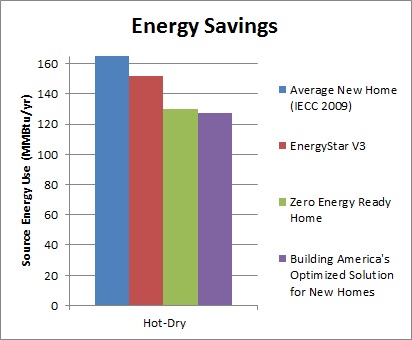Hot-Dry/Mixed-Dry

This Building America Optimized Solution describes a set of building practices necessary to achieve the next step in energy performance for new homes (approximately 30% energy savings above the B10 Benchmark - roughly consistent with the 2009 International Energy Conservation Code). This package of measures meets and exceeds DOE’s Zero Energy Ready Home (ZERH) program requirements and was selected for its performance in the following areas:
- Energy Savings
- Affordability
- Buildability
- Durability
- Healthy Indoor Environment
The high performance builders profiled in the case studies found below the interactive box show just a few examples of the hundreds of ways a builder can meet the premium levels of energy savings Building America strives for, while qualifying for the ZERH. Print the Optimized Solution for the Hot-Dry/Mixed-Dry Climate.
Energy Savings

HVAC System
| Measure | Performance | Options |
|---|---|---|
|
Heating Equipment
|
80% AFUE (Gas) or 8.2 HSPF (Electric) |
|
|
Cooling Equipment
|
18 SEER |
|
|
Whole-House Ventilation
|
ASHRAE 62.2, 5 cfm/W and No Heat Recovery |
Thermal Enclosure
| Measure | Performance | Options |
|---|---|---|
|
High-R Ceiling
|
R-30 |
|
|
High-R Walls
|
R-13 Cavity and R-5 Continuous |
|
|
High-R Foundation
|
Uninsulated (Slab) |
|
|
High-R Window
|
U≤0.4 (R≥2.5), SHGC≤0.25 |
|
|
Air Tightness
|
ACH50≤2 |
Efficient Components
| Measure | Performance | Options |
|---|---|---|
|
Water Heating
|
EF 0.8 |
|
|
Lighting
|
ENERGY STAR |
|
|
Appliances
|
ENERGY STAR |
|
|
Exhaust Fans
|
ENERGY STAR |
|
|
Ceiling Fans
|
ENERGY STAR |